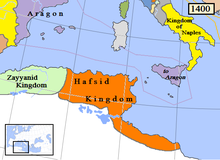Conquest of Tunis (1574)
| Conquest of Tunis | |||||||||
|---|---|---|---|---|---|---|---|---|---|
| Part of the Ottoman-Habsburg wars | |||||||||
 The Ottoman fleet attacking Tunis at La Goulette in 1574. | |||||||||
| |||||||||
| Belligerents | |||||||||
|
|
| ||||||||
| Commanders and leaders | |||||||||
|
|
| ||||||||
| Strength | |||||||||
| Total men: 7,000 |
250–300 warships Total men: 100,000 | ||||||||
| Casualties and losses | |||||||||
| 6,700 killed, 300 prisoners |
25,000[2] (Spanish claim) | ||||||||
The conquest of Tunis in 1574 marked the conquest of Tunis by the Ottoman Empire over the Spanish Empire, which had seized the place a year earlier. The event virtually determined the supremacy in North Africa vied between both empires in favour of the former,[3] sealing the Ottoman domination over eastern and central Maghreb,[4] with the Ottoman dependencies in Algiers, Tunis and Tripoli ensuingly coming to experience a golden age as corsair states.[3]
Background
Tunis had
Capture of Tunis
In 1574,
In the Battle of


John of Austria attempted to relieve the siege with a fleet of galleys from Naples and Sicily but failed due to storms.[10] The Spanish crown, being heavily involved in the Netherlands and short of funds was unable to help significantly.[10]
Miguel de Cervantes, future author of Don Quixote, participated in these events as a soldier, and was among the troops of Don Juan of Austria which tried to rescue the city.[2] He claims that the Ottomans led 22 assaults against the fort of Tunis, losing 25,000 men, while only 300 Christians survived.[2] He wrote about the battle:
"If Goleta and the fort, put together, held barely 7,000 soldiers, how could such a small force, however resolute, come out and hold its own against so huge an enemy army. And how can you help losing a stronghold that is not relieved, and especially when it is surrounded by a stubborn and very numerous army, and on its own ground?"
— Cervantes, DQ I, 39.[2]
Abd al-Malik, the future Moroccan King, participated in the 1574 conquest of Tunis on the side of the Ottomans.[11]
Gabrio Serbelloni was the commander of the fort of Tunis. The general of La Goleta, Don Pedro Portocarerro, was taken as a captive to Constantinople, but died on the way.[2] The captured soldiers were employed as slaves on galleys.[2]

The battle marked the final establishment of Ottoman rule in Tunis, putting an end to the Hafsid dynasty and the Spanish presence in Tunis.[5]
Aftermath
The success of the Turks under
After the truce, Ottoman-Spanish hostilities resumed in 1591, even if they would not reach the magnitude of yesteryear.[14]
See also
- Ottoman Tunisia
- Siege of Castelnuovo
- Islam and Protestantism
- Franco-Ottoman alliance
Notes
- ^ a b c d Setton, Kenneth Meyer (1984). The Papacy and the Levant, 1204–1571: Vol.IV. Philadelphia.
{{cite book}}: CS1 maint: location missing publisher (link) - ^ a b c d e f Garcés, p.222
- ^ a b c The new Cambridge modern history R. B. Wernham, p.354
- ISBN 0-415-29781-8, p.3 [1]
- ^ a b [2][dead link]
- ISBN 9780710088659. Retrieved 18 March 2013.
- ^ a b c d Parker, p.61
- ISBN 9780826514707. Retrieved 18 March 2013.
- ^ a b c Garcés, p.220
- ^ a b c Garcés, p.221
- ^ The last great Muslim empires: history of the Muslim world by Frank Ronald Charles Bagley, Hans Joachim Kissling p.103ff
- ^ Tarih Sitesi: Kılıç Ali Paşa
- ^ Goris, J.A. (1922-1923) Turksche kooplieden te antwerpen in de XVIe Bijdragentot de Geschiedenis 14/1:30
- ISSN 1130-4340.
References
- ISBN 0-7100-8865-5
- María Antonia Garcés Cervantes in Algiers: A Captive's Tale Vanderbilt University Press, 2005 ISBN 0-8265-1470-7
